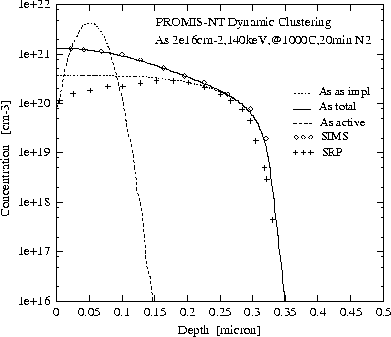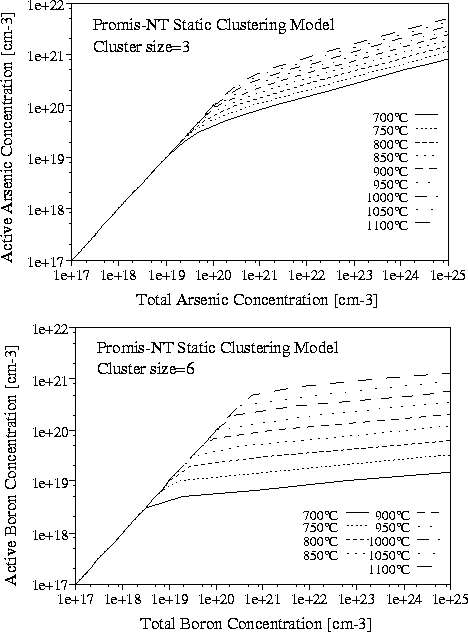
Figure 4.3-3: Simulation of arsenic clustering using the dynamic cluster model. The active and total arsenic concentrations are given after 20min annealing at

Figure 4.3-3: Simulation of arsenic clustering
using the dynamic cluster model. The active and total arsenic concentrations
are given after 20min annealing at ![]() .
.
In the case of boron, it is much more complicate to illustrate the pure
clustering behavior. According to boron clustering models in the literature
[Pic90], we define boron clusters to consist of six dopant atoms and
six electrons ( ![]() ). During boron diffusion several mechanisms are
affecting the final profile. We use a dynamic clustering model to verify the
observed transient enhanced diffusivity of boron, see for instance
Section 4.3.3. Thereby clustering occurs in the highly
doped regions and the clustered dopants are excluded for diffusion
enhancement due to point defects. Dynamic clustering parameters for boron
applied to the transient enhanced diffusion model are given in (see
Table 4.3-1).
). During boron diffusion several mechanisms are
affecting the final profile. We use a dynamic clustering model to verify the
observed transient enhanced diffusivity of boron, see for instance
Section 4.3.3. Thereby clustering occurs in the highly
doped regions and the clustered dopants are excluded for diffusion
enhancement due to point defects. Dynamic clustering parameters for boron
applied to the transient enhanced diffusion model are given in (see
Table 4.3-1).
Additionally, we give parameters for the static clustering model including
data for silicon interstitial clusters. These data are extracted
from boron transient enhanced diffusion experiments
[Sol91]. Furthermore, all parameters are modeled by an Arrhenius
expression ( ![]() ) and the clustering rate is scaled
to the electron and dopant cluster sizes for comparison reasons
) and the clustering rate is scaled
to the electron and dopant cluster sizes for comparison reasons
( ![]() ). Figure 4.3-4
illustrates the static clustering model for arsenic and boron with respect
to several temperatures.
). Figure 4.3-4
illustrates the static clustering model for arsenic and boron with respect
to several temperatures.

Figure 4.3-4: Active versus total
dopant concentrations in grain interiors using a static clustering model for
arsenic. The temperature dependence of this equilibrium model is also
shown. Clustering parameters are taken from [Pic90].
| Dynamic Clustering Parameters | ||||||
| Dopant | | | | |
| |
| As | 3 | 1 | | |
| |
| B | 6 | 6 | | |
| 10.45eV |
| Static Clustering Parameters | ||||||
| Dopant | | | |
| ||
| As | 3 | 1 | |
| ||
| B | 6 | 6 | |
| ||
| Si-I | 6 | 6 | |
| ||